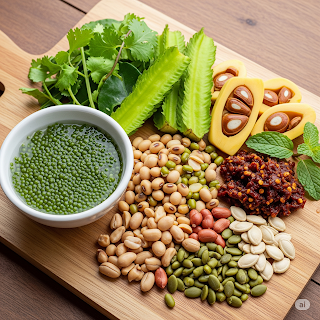From Soybeans to Wolffia: Thailand’s Most Powerful Plant Proteins
Discover Thailand’s top plant proteins, from soybeans to nutrient-rich Wolffia, featured by HuaHinServices. Explore how these sustainable, protein-packed plants support traditional Thai diets and healthy living in Hua Hin and beyond.
Most Important Thai Plants with Protein
Thailand has a variety of native and cultivated plants rich in protein, many of which are staples in traditional diets. Here’s a comprehensive list of the most significant ones:
1. Soybeans (ถั่วเหลือง - Thua Liang)
- Protein: ~36g per 100g (dry)
- Uses: Tofu, soy milk, fermented pastes (เต้าเจี้ยว, น้ำมันถั่วเหลือง)
- Key Role: Primary plant-based protein in Thai cuisine.
2. Mung Beans (ถั่วเขียว - Thua Khiao)
- Protein: ~24g per 100g (dry)
- Uses: Bean sprouts, desserts (ขนมถั่วเขียว), cellophane noodles (วุ้นเส้น)
3. Peanuts (ถั่วลิสง - Thua Lisong)
- Protein: ~25g per 100g
- Uses: Satay sauce, snacks, Pad Thai topping
4. Black Beans (ถั่วดำ - Thua Dam)
- Protein: ~21g per 100g (dry)
- Uses: Sweet soups, traditional desserts
5. Winged Beans (ถั่วพู - Thua Phu)
- Protein: 10-15g (pods), up to 20% (tubers)
- Uses: Eaten raw in salads, stir-fried, or as a root vegetable
6. Wolffia / Watermeal (ผำ or ไข่น้ำ - Pham or Khai Nam) 🌿 NEW ADDITION
- Protein: 20-30% (dry weight), a complete protein (all 9 essential amino acids)
- Uses: Eaten raw in salads (ยำผำ - Yam Pham), in soups, or with chili paste
- Why Special? One of the most protein-dense plants, sustainable, and traditionally consumed in Northern/Isan Thailand.
7. Sesame Seeds (งา - Nga)
- Protein: ~18g per 100g
- Uses: Toppings, desserts, sauces
8. Pumpkin Seeds (เม็ดฟักทอง - Met Fak Thong)
- Protein: ~19g per 100g
- Uses: Roasted snacks, added to dishes
9. Lotus Seeds (เม็ดบัว - Met Bua)
- Protein: ~15g per 100g (dried)
- Uses: Desserts, traditional medicine
10. Young Jackfruit (ขนุนอ่อน - Khanun On)
- Protein: ~3g per 100g (used as meat substitute)
- Uses: Vegan "pulled pork" in curries (แกงขนุน) Kaeng Phet Khanun On (แกงเผ็ดขนุนอ่อน) – young jackfruit curry: A Treasured Thai Curry or Vegan Thai Fingerroot & Fresh Jackfruit Yellow Curry
Bonus: Spirulina & Insects
- Spirulina (สาหร่ายสไปรูลิน่า): Up to 60-70% protein, used as a supplement.
- Edible Insects (จิ้งหรีด, ดักแด้): Crickets (20g protein) and silkworm pupae (15g protein) are traditional protein sources.
Conclusion
While soybeans and mung beans dominate Thai cuisine, lesser-known plants like Wolffia (ผำ) offer exceptional protein density and sustainability. Northern and Isan Thai communities have long used Pham in salads, while modern nutrition science now recognizes it as a future superfood.




Comments
Post a Comment